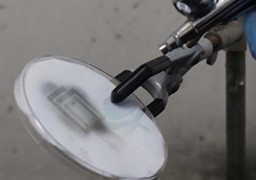5G мӮ¬л¬ј мқён„°л„·мқ„ мң„н•ң вҖҳл§үм„јвҖҷ м•Ҳн…ҢлӮҳмқҳ лҜёлһҳ
вҖҳм–ҙл“ңл°ҙмҠӨл“ң л§Өн„°лҰ¬м–јмҠӨ(Advanced Materials)вҖҷ м Җл„җм—җ л°ңн‘ңлҗң л°”мҷҖ к°ҷмқҙ, мҠӨн”„л Ҳмқҙ 분мӮ¬ нҳ•нғңлЎң м ңмһ‘ к°ҖлҠҘн•ң м–ҮмқҖ мғҲлЎңмҡҙ м•Ҳн…ҢлӮҳк°Җ 5G лӘЁл°”мқј мһҘм№ҳм—җм„ң мӮ¬мҡ©н• лҢҖм—ӯнҸӯмқҳ к°•л Ҙн•ң мӢ нҳёлҘј л°ӣлҠ”лҚ° 충분н•ң кІғмңјлЎң лӮҳнғҖлӮ¬лӢӨ. л§үм„ј(MXene)мқҙлқјлҠ” мғҲлЎңмҡҙ мң нҳ•мқҳ 2л©ҙ мһ¬лЈҢлЎң л§Ңл“Өм–ҙ진 мқҙ м•Ҳн…ҢлӮҳлҠ” вҖҳмӮ¬л¬ј мқён„°л„·вҖҷ кё°мҲ м—җ мӨ‘мҡ”н•ң мҳҒн–Ҙмқ„ лҜём№ мҲҳ мһҲлӢӨ.
л“ңл үм…Җ лҢҖн•ҷкөҗ(Drexel University)м—җм„ң к°ңл°ңлҗң л§үм„ј м•Ҳн…ҢлӮҳлҠ” мҳӨлҠҳлӮ лҢҖл¶Җ분мқҳ лӘЁл°”мқј мһҘм№ҳм—җм„ң ліј мҲҳ мһҲлҠ” кө¬лҰ¬ м•Ҳн…ҢлӮҳмҷҖ кұ°мқҳ к°ҷмқҖ м„ұлҠҘмқ„ л°ңнңҳн•ҳм§Җл§Ң кө¬лҰ¬ м•Ҳн…ҢлӮҳмқҳ л‘җк»ҳмҷҖ л¬ҙкІҢмқҳ мқјл¶Җм—җ л¶Ҳкіјн•ҳлӢӨлҠ” мқҙм җмқ„ к°–кі мһҲлӢӨ.
мқҙлҹ¬н•ң нҶөмӢ м„ұлҠҘкіј к·№лҸ„мқҳ м–ҮмқҢ, мң м—°м„ұ л°Ҹ лӮҙкө¬м„ұмқҳ мЎ°н•©мқҖ м•Ҳн…ҢлӮҳ кё°мҲ мқҳ мғҲлЎңмҡҙ н‘ңмӨҖмқ„ м •мқҳн•ҳкі мһҲлӢӨ. кө¬лҰ¬ м•Ҳн…ҢлӮҳлҠ” кҪӨ мҳӨлһ«лҸҷм•Ҳ м„ұлҠҘ л©ҙм—җм„ң мөңкі мҳҖлӢӨ. н•ҳм§Җл§Ң л¬јлҰ¬м Ғ н•ңкі„лЎң мқён•ҙ вҖҳм—°кІ°вҖҷ л°Ҹ вҖҳлӘЁл°”мқјвҖҷ кё°мҲ м—җ мһҲм–ҙ л§ҺмқҖ мӮ¬лһҢл“Өмқҙ мҳҲмғҒн–ҲлҚҳ л°”мҷҖ к°ҷмқҙ нҒ° лҸ„м•Ҫмқ„ мқҙ루진 лӘ»н–ҲлӢӨ. к·ёлҹ¬лӮҳ кі мң н•ң нҠ№м„ұмңјлЎң мқён•ҙ л§үм„ј м•Ҳн…ҢлӮҳлҠ” вҖҳмӮ¬л¬ј мқён„°л„·вҖҷ кё°мҲ к°ңл°ңм—җм„ң мӨ‘мҡ”н•ң м—ӯн• мқ„ лӢҙлӢ№н• мҲҳ мһҲлӢӨ.
мӢ нҳё мІҳлҰ¬ кё°лҠҘ мҷём—җлҸ„ лҜёлһҳмқҳ мһҘм№ҳмҡ© м•Ҳн…ҢлӮҳлҠ” м „нҷ” л°Ҹ м»ҙн“Ён„°мқҳ нҡҢлЎң кё°нҢҗ мҷёл¶Җ нҷҳкІҪм—җм„ңлҸ„ мһ‘лҸҷн• мҲҳ мһҲм–ҙм•ј н•ңлӢӨ. л”°лқјм„ң л§үм„јмқҖ кұ°мқҳ лӘЁл“ кё°нҢҗм—җ мҠӨн”„л Ҳмқҙ л°©мӢқмқ„ м Ғмҡ©н•ҳм—¬, мҠӨнҒ¬лҰ° мқёмҮ„ лҳҗлҠ” мһүнҒ¬м Ҝ мқёмҮ„к°Җ к°ҖлҠҘн•ҳкі м„ұлҠҘ м Җн•ҳ м—Ҷмқҙ мң м—°м„ұмқ„ мң м§Җн•ҳкё° л•Ңл¬ём—җ мғҲлЎңмҡҙ м•Ҳн…ҢлӮҳм—җ лҢҖн•ң м•„мЈј л§Өл Ҙм Ғмқё мҶҢмһ¬мқҙлӢӨ. мҰү, л§үм„јмқҖ л¬јкіј мңөн•©н•ҳм—¬ м•Ҳн…ҢлӮҳлҘј л§Ңл“Өкё° мң„н•ҙ мҠӨн”„л ҲмқҙлЎң 분мӮ¬лҗҳкұ°лӮҳ мқёмҮ„лҗ мҲҳ мһҲлҠ” мһүнҒ¬лЎң м ңмһ‘ к°ҖлҠҘн•ҳкё° л–„л¬ёмқҙлӢӨ.
вҖҳм–ҙл“ңл°ҙмҠӨл“ң л§Өн„°лҰ¬м–јмҠӨвҖҷм—җ мҶҢк°ңлҗң мҠӨн”„л Ҳмқҙ 분мӮ¬лЎң мҪ”нҢ…лҗң л§үм„ј м•Ҳн…ҢлӮҳлҠ” мң мӮ¬н•ң кө¬лҰ¬ м•Ҳн…ҢлӮҳліҙлӢӨ 7~14л°°, 15~30л°° лҚ” к°ҖлІјмҡ°л©° нҺҳмқёнҠё мҪ”нҢ…ліҙлӢӨ лҚ” м–ҮлӢӨ. м—°кө¬мһҗл“ӨмқҖ мқјл°ҳм ҒмңјлЎң нҶөмӢ м—җ мӮ¬мҡ©лҗҳлҠ” 3к°Җм§Җ л¬ҙм„ мЈјнҢҢмҲҳм—җ лҢҖн•ң мқҙл“қ, л°©мӮ¬ нҡЁмңЁм„ұ л°Ҹ м§Җн–Ҙм„ұмқ„ мң„н•ҙ мӢӨн—ҳмӢӨкіј к°ңл°©нҳ• нҷҳкІҪм—җм„ң мқҙ мғҲлЎңмҡҙ м•Ҳн…ҢлӮҳлҘј н…ҢмҠӨнҠён–ҲлӢӨ. м—¬кё°м—җлҠ” 5G мһҘм№ҳмқҳ лӘ©н‘ң мЈјнҢҢмҲҳлҸ„ нҸ¬н•Ёлҗҳм—ҲлӢӨ.
к°Ғ кІҪмҡ°, л§үм„ј м•Ҳн…ҢлӮҳлҠ” кө¬лҰ¬ м•Ҳн…ҢлӮҳмқҳ нҒ¬кё° 5% лӮҙм—җм„ң мҲҳн–үлҗҳм—Ҳмңјл©° м•Ҳн…ҢлӮҳ л‘җк»ҳм—җ л”°лқј м„ұлҠҘмқҙ мҰқк°Җн–ҲлӢӨ. л§үм„јмқҖ лҳҗн•ң 5G лҢҖм—ӯнҸӯм—җм„ң мһ‘лҸҷн•ҳлҠ” кө¬лҰ¬ м ңн’ҲліҙлӢӨ 98% лҚ” нҡЁкіјм Ғмқҙм—ҲлӢӨ.
л§үм„ј м•Ҳн…ҢлӮҳмқҳ м„ұлҠҘмқҖ мқҖ мһүнҒ¬, нғ„мҶҢ лӮҳл…ёнҠңлёҢ, к·ёлһҳн•Җмқ„ нҸ¬н•Ён•ҳм—¬ м•Ҳн…ҢлӮҳмҡ©мңјлЎң нҳ„мһ¬ кі л Ө мӨ‘мқё м—¬лҹ¬ мӢ мҶҢмһ¬мқҳ м„ұлҠҘмқ„ лҠҘк°Җн•ҳкі мһҲлӢӨ. лҚ” мӨ‘мҡ”н•ң кІғмқҖ, мқҙлҹ¬н•ң м„ұлҠҘ мҲҳм№ҳлҠ” л§үм„ј м•Ҳн…ҢлӮҳк°Җ лӢӨлҘё мһ¬лЈҢлҘј нӣЁм”¬ лҠҘк°Җн•ҳлҠ” лӮҙкө¬м„ұм—җ мһҲлҠ”лҚ°, мөңлҢҖ 5,000лІҲмқҳ көҪнһҳ мЈјкё°лҘј кІӘм—Ҳмқ„ л•ҢлҸ„ нҳ•нғңлҘј мң м§Җн–ҲлӢӨ. м ңмЎ° 분야м—җм„ң л§үм„јмқҳ нҷ•мһҘм„ұкіј нҷҳкІҪм Ғ м§ҖмҶҚ к°ҖлҠҘм„ұмқҖ мқҙлҜё мһҳ нҷ•лҰҪлҗҳм–ҙ мһҲм–ҙ, н–Ҙнӣ„ л§үм„ј м•Ҳн…ҢлӮҳм—җ лҢҖн•ң к°ңл°ңмқҖ лҚ” нҒ° нҸӯмңјлЎң 진н–үлҗ кІғ к°ҷлӢӨ.
[References]
Advanced Materials, November 2020, вҖңSolution‐Processed Ti 3 C 2 T x MXene Antennas for Radio‐Frequency Communication,вҖқ by Meikang Han, et al. © 2020 John Wiley & Sons, Inc. All rights reserved.
To view or purchase this article, please visit:
Solution‐Processed Ti3C2Tx MXene Antennas for Radio‐Frequency Communication - Han - 2021 - Advanced Materials - Wiley Online Library
As described in the journal Advanced Materials, new antennas so thin that they can be sprayed into place are also robust enough to provide a strong signal in the bandwidths that will be used by 5G mobile devices. The antennas, which are made from a new type of two-dimensional material called MXene, could have important ramifications for вҖңinternet of thingsвҖқ technology.
The MXene antennas, developed at Drexel University perform nearly as well as the copper antennas found today in most mobile devices, but with the benefit of being just a fraction of their thickness and weight.
This combination of communications performance with extreme thinness, flexibility, and durability sets a new standard for antenna technology. While copper antennas have been the best in terms of performance for quite some time, their physical limitations have prevented connected and mobile technology from making the big leaps forward that many predicted. But, due to their unique set of characteristics MXene antennas could play an enabling role in the development of вҖңinternet of thingsвҖқ technology.
Beyond signal handling capabilities, antennas for devices of the future must also be able to perform in environments outside of the circuit boards of phones and computers. This makes MXene an appealing material for new antennas because it can be spray applied, screen printed, or inkjet-printed onto just about any substrate and remains flexible without sacrificing performance. This puts MXene at a distinct advantage because it disperses in water to produce ink, which can be sprayed or printed to create antennas.
The spray-coated MXene antennas described in Advance Materials were between 7-14 times thinner and 15-30 times lighter than similar copper antennae, even thinner than a coat of paint. The researchers tested the antennas in both lab and open environments for gain, radiation efficiency, and directivity across the three radio frequencies commonly used for telecommunication. This included one in the target frequency for 5G devices.
In each instance, the MXene antennas performed within 5 percent of copper antennas, with performance increasing with the thickness of the antenna. MXenes were also 98 percent as effective as their copper counterparts operating in the 5G bandwidth.
Their performance exceeded that of several new materials being considered for antennas, including silver ink, carbon nanotubes, and graphene. And, significantly, these performance numbers did not waiver when the MXene antennas were subjected to as many as 5,000 bending cycles — a mark of durability that far surpasses other materials.
MXeneвҖҷs scalability and environmental sustainability in manufacturing have been well established.
References
Advanced Materials, November 2020, вҖңSolution‐Processed Ti 3 C 2 T x MXene Antennas for Radio‐Frequency Communication,вҖқ by Meikang Han, et al. © 2020 John Wiley & Sons, Inc. All rights reserved.
To view or purchase this article, please visit:
Solution‐Processed Ti3C2Tx MXene Antennas for Radio‐Frequency Communication - Han - 2021 - Advanced Materials - Wiley Online Library







